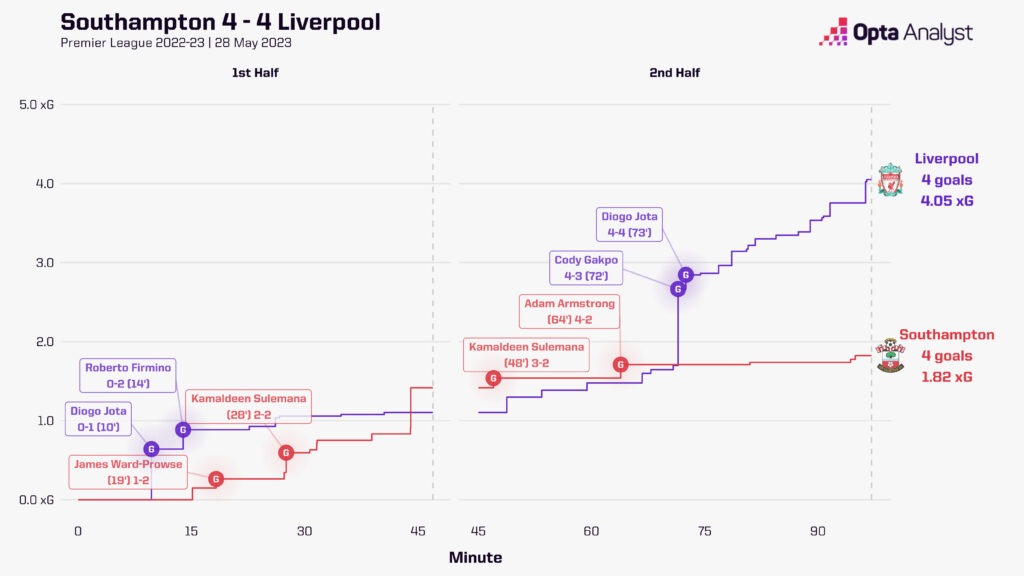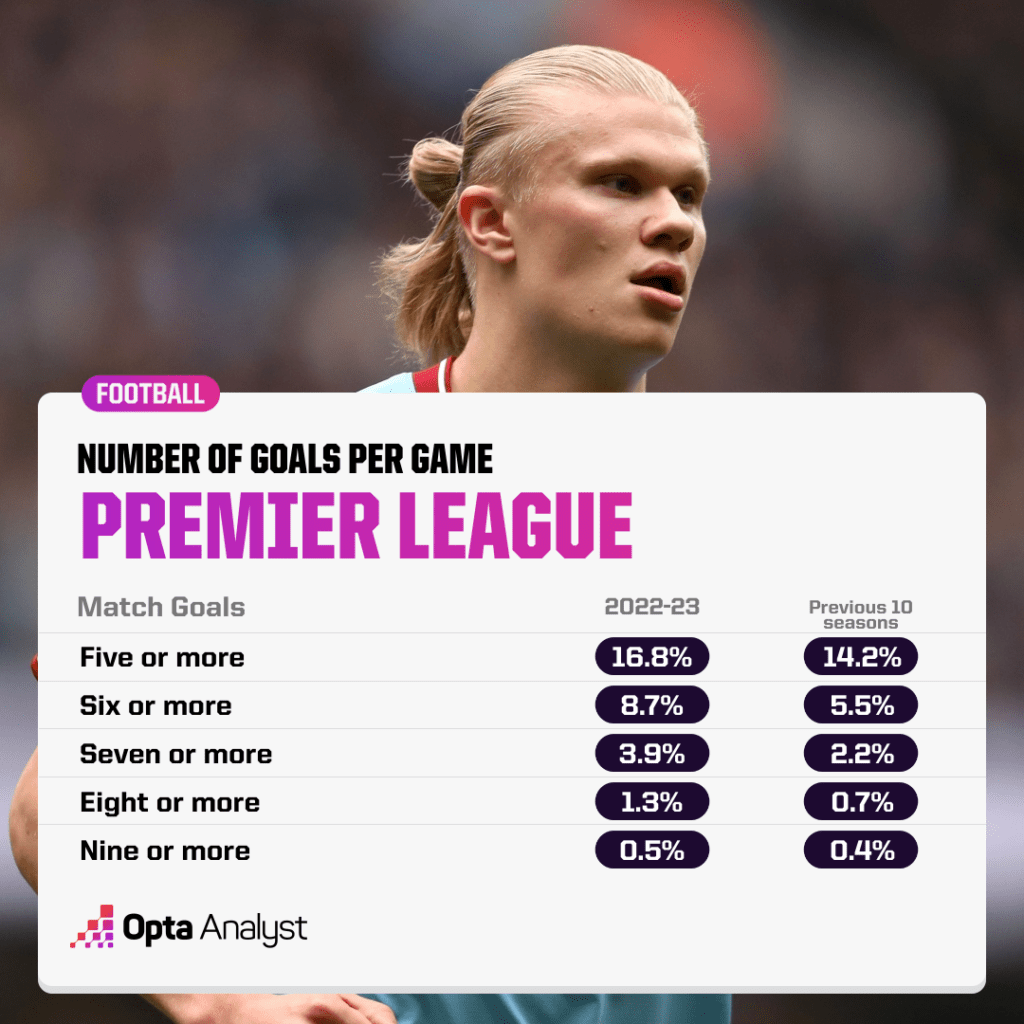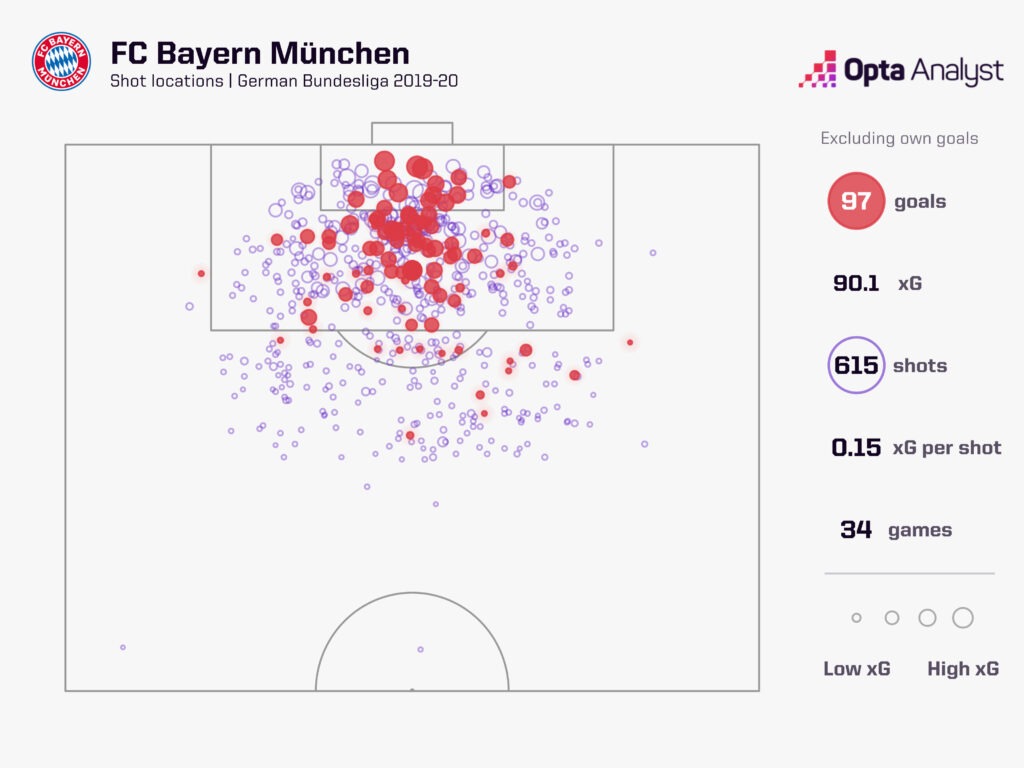Sunday saw another 33 goals scored on the Premier League’s final day, which continued a trend of high-scoring clashes in England’s top flight. But just how historic was the scoring rate in 2022-23?
If you like your football with plenty of goals, then this season’s Premier League has been the place to be.
James Ward-Prowse’s stoppage-time penalty in Southampton’s 4-3 defeat at Nottingham Forest on 8 May was the 21st goal of that day across just three games. It felt like the football equivalent of the famous restaurant scene from Monty Python’s The Meaning of Life, where we couldn’t possibly indulge ourselves any further, but once the “wafer-thin mint” of a penalty was awarded, the enjoyment of another goal being scored could well have exploded and left merely a feeling of: “This is too many goals, isn’t it?”
That day carried on the theme of the season in England’s top flight, which was goals by the barrelful. The campaign closed on Sunday with a further 33 added to the final total, which ended up with 2022-23 seeing the most goals ever in a Premier League season, aided by the token bonkers game on the last day, this time provided by Southampton and Liverpool as they played out a 4-4 draw.
Somewhat appropriately, Abdoulaye Doucouré’s effort against Bournemouth was not only the most important goal of the day as it kept Everton in the league but also ended up being the goal that broke the previous record of 1,072 for a single campaign.
Prior to this season, it was the 2018-19 campaign that held the record, but 2022-23 ended with 1,084 goals scored at an average of 2.85 per game.

It perhaps suggests a developing trend as the next highest-scoring campaign was 2021-22, where 1,071 goals were scored across the 380 games, while the lowest-scoring season in the Premier League era came in 2006-07, with 931 goals at an average of 2.45 per game.
Leicester City exemplified this best in 2022-23 as they scored 51 league goals across the season, as many as seventh-placed Aston Villa, but were ultimately relegated.
In fact, it perhaps goes to show that goalscoring is not all it’s cracked up to be as the Foxes recorded more than any other team in the bottom half of the table, with the second-most scored by Leeds United (48), who also dropped out of the division. Leicester did not overtake Blackpool (55) though as the relegated team to have scored the most goals in Premier League history.

It was not just the overall number of goals that were notable but the number of high-scoring games we saw in the Premier League this season. Liverpool’s 9-0 hammering of Bournemouth in August to equal the league’s biggest ever win may not have been a sign of things to come from Jürgen Klopp’s men but was perhaps an indicator that a wider trend was on the way.
There were 15 Premier League games in 2022-23 that saw seven or more goals scored, with only the 2020-21 season (also 15) seeing as many, while the percentage of games with six or more goals was noticeably up on recent years. Overall, 8.7% of games in 2022-23 featured six or more goals scored, with the average across the previous 10 campaigns being 5.5%, while 3.9% had seven or more (up from 2.2% in previous 10 seasons) and 1.3% saw eight or more goals (up from 0.7%).

Much like their beer glasses though, the Germans go bigger. This may have been the highest-scoring Premier League season, but the Bundesliga regularly provides more value per game when it comes to beating goalkeepers.
In 21 of the last 30 seasons, the German top-flight has seen more than 2.85 goals per game, with the 2019-20 campaign producing the most at 3.21 per game from 306 clashes. The top five highest-scoring seasons across Europe’s top-five leagues have all stemmed from Germany, with four of those five coming in the last five years. In that 2019-20 campaign, champions Bayern Munich scored 100 goals, while their closest rivals Borussia Dortmund (84) and RB Leipzig (81) also added their fair share.

The only other of Europe’s top five leagues to record an average of over three goals per game in a season in that time has been Serie A, belying the old-fashioned notion that Italian football is primarily defensive and devoid of goal gluts. The 2019-20 campaign (3.04 per game) was aided by Atalanta smashing 98 goals, while even relegated Lecce managed 52. The following season saw even more goals (3.05 per game), with Atalanta hitting another 90 while champions Inter scored 89 and fifth-placed Napoli managed 86.
While it might be a Premier League record, this season was just the 30th highest scoring since 1992 among Europe’s top five leagues, but that is still significant in English football at least, as it was the highest-scoring campaign per game in the country’s top-flight since the 1967-68 season.
There were 1,398 goals scored across 462 games that season at an average of 3.03 per game, which concluded a sustained period of goal-filled campaigns that had seen an average of at least three per game every season since 1950-51.
Whether it was down to the emergence of the 4-4-2 formation in the mid-1960s or simply a natural swing from focusing on attacking to focusing on defending, there was quite a remarkable downturn in goals after that, with what remains the lowest-scoring season in English top-flight history only coming a few years later in 1970-71 (2.36 goals per game).
One interesting aspect of the recent upturn is the introduction of video assistant referees to the Premier League in 2019-20. One argument against VAR was that it would lead to more goals being disallowed than before, and the average goals-per-game did go down in its first two years, but it has since seemingly had the opposite effect as the last two seasons have seen as many goals as the competition has had before.
It might be thoroughly annoying to wait for a VAR intervention but perhaps the officials are getting the hang of it now, leading to fewer goals being wrongly ruled out for offside and defenders being allowed less licence to get away with what we shall generously call the dark arts, in addition to the always controversial and clear as mud handball rule, so it could be that we are seeing more goals thanks to VAR rather than fewer.
Though it is unlikely the English game will return to the wacky days of regularly averaging three goals or more per game, it does seem like scoring plenty is becoming a trend once again. So in 2023-24, expect to continue being delighted by more opportunities to celebrate, only to be equally annoyed by VAR checks and weird choreographed celebrations.
Enjoy this? Subscribe to our mailing list to receive exclusive weekly content. And follow us on Twitter too.
